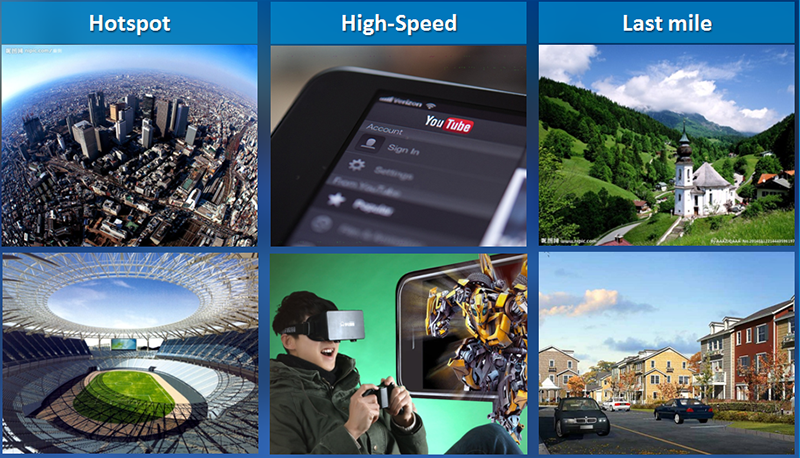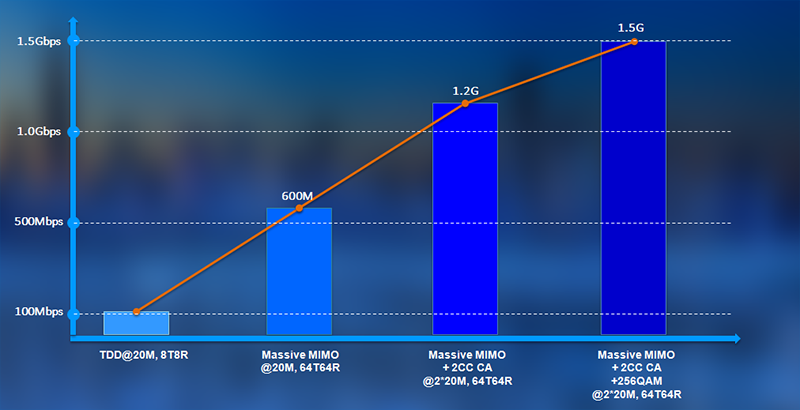Giga+ MBB, Flying your Network
Application Background
With the rapid development of mobile terminals and mobile applications, the requirements of mobile bandwidth grew explosively. Although, the current 4G network can meet most of the requirements of data services like video, web surfing, social media, etc., with the new services like HD/UHD video, VR/AR, etc. entering the daily life, the bandwidth capability of 4G network can’t meet the requirements in some hotspots.
1. Hotspot with High Rraffic
Normally, hotspots are located in the CBDs, plazas, commercial centers, stations, stadiums, etc. with high dense population, high data traffic, high buildings and complex network environments.
2. Ultra-High Data Rate Requirement
Ultra-high data rate services include HD/UHD video, HD online game, VR, AR, etc., with high user experience bandwidth and low network latency.
3. Last Mile for Broadband Access
For some uncontrolled reasons like municipal authority, private property, etc., the fixed network operators can’t provide the FTTH service for some communities. ZTE Pre5G can realize the fast, low-cost and fiber-like solution to meet the requirement of last mile access.

Key Technologies
1. Massive MIMO
As 5G key technology, ZTE is the first to introduce Massive MIMO technology into 4G network. Through introducing massive antenna array and multi-antenna spatial multiplex, the spectrum efficiency of Pre5G is improved to 3-6 times compared with that of a traditional 4G base station. Furthermore, 3D beam forming technology brings deeper, wider and more precise coverage.
2. Pre UDN
Pre UDN is also a 5G technology applied to the 4G network. Deploying Ultra-dense sites in hotspots and realizing coordination between multi-sites, Pre UDN can not only solve the limitation of capacity but also eliminate the interference of cell edge to the maximum degree.
3. Massive CA
CA (Carrier Aggregation) is a key technology to improve the network capacity while Massive CA is a special CA technology supporting more than 5CC and TDD/FDD CC. For the requirements of ultra-high interactive data and low latency, Massive CA requires the co-sites scenario while ZTE introduced the C-RAN structure to eliminate the limitation of co-sites and meet more application scenarios.
4. 256QAM
As a higher order modulation technology, 256QAM realized the 33% improvement of peak rate compared with 64QAM. However, due to the limitation of a strict wireless environment, 256QAM is usually adopted for the indoor coverage.
5. LAA/LWA
Normally, for the reasons of security and stability, the licensed spectrums are adopted into telecom industry but with high cost and limited bands, in Pre5G solution, the unlicensed spectrums are starting to be adopted into the telecom industry as a complementary resource to meet the requirement of large bandwidth. LAA and LWA are just the technologies to use the unlicensed spectrum in the LTE and WIFI network, through combining with LTE licensed spectrum, the bandwidth and capacity can realize an obvious improvement.
Through the combination of above technologies, the Pre5G reached Giga+ capability.

Commercial Progress
1. September 2014, ZTE released the first Massive MIMO base station in the world
2. January 2015, ZTE started a Massive MIMO field trial cooperating with CMCC
3. March 2015, ZTE Massive MIMO got the innovative award from GTI in MWC2015
4. December 2015, ZTE started a Massive MIMO field trial in Japan
5. February 2016, ZTE Massive MIMO got the 2 largest awards from GSMA in MWC2016
6. February 2016, ZTE Massive CA demonstrated the FDD/TDD 5CC CA in MWC2016
The whole commercial progresses are shown below;
